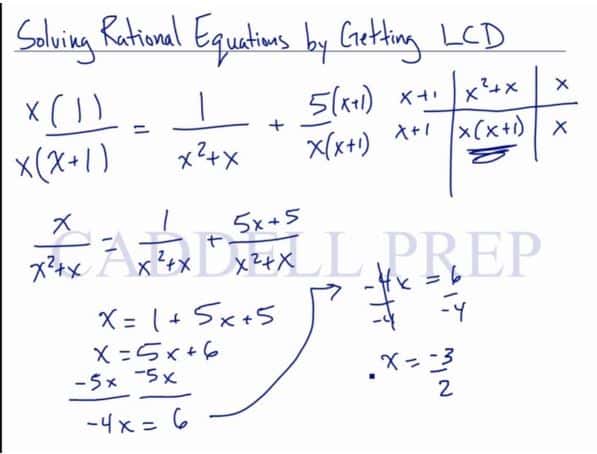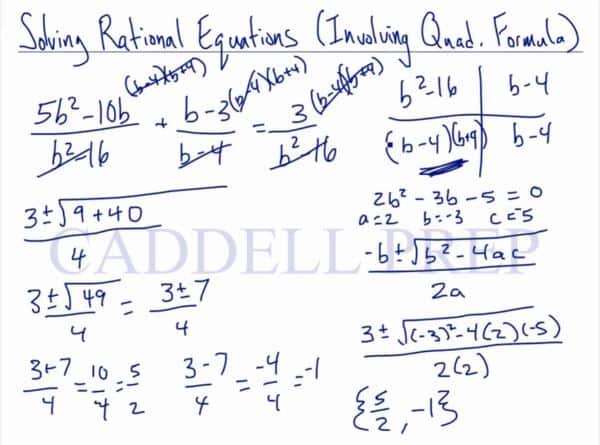Solving Rational Equations by Getting LCD
In the first video, we are going to solve rational equations by getting the LCD (Least Common Denominator). After you finish this lesson, view all of our Algebra 1 lessons and practice problems.
For Example:
Find the LCD, which is . Multiple each expression to get its denominator to
Multiply
Now that the denominators are the same, we can add across
Solve the equation for the value of x. Combine like terms
Move x to one side of the equation
Isolate x and we have
Video-Lesson Transcript
Let’s go over how to solve rational equations.
In this method, we’re going to do it by getting the least common denominator (LCD).
First, let’s examine the denominators here.
One way to get the least common denominator is to multiply them together.
We want to examine these denominators so we can tell the factors.
stays the same as well as
.
But can be factored out into
.
This denominator is the first one times the last one.
Which makes this the least common denominator.
So, we’ll have
At this point, we can drop the denominators.
Since we already have common denominators, we can just add the numerators.
So, what’s really important is that we have a common denominator so we can add the numerators.
Here, we can find the value of .
Solving Rational Equations by Multiplying by LCD
In the second video, we are going to solve rational equations by multiplying by the LCD (Least Common Denominator).
For example:
Determine the LCD of the three denominators, which is 2(x-6)(x+4). Multiply the numerators by the LCD
Reduce each expression
Multiply
Use the distributive property
Move x to one side of the equation by subtracting x
Subtract 8 from both sides to isolate x, and we have
Video-Lesson Transcript
Let’s go over solving rational expressions by multiplying by the least common denominator.
For example:
First, let’s look at the denominators.
We’ll get the common denominator by multiplying these together.
For us to get the least common denominator, let’s factor and see what we’ll end up with.
becomes
factored is
and can still be reduced as
.
stays as it is.
The second factored denominator is the least common denominator.
Instead of having the same denominator, we’ll just multiply each term by the least common denominator so we can cancel out later on.
When multiplied, the equation remains the same since we didn’t do anything mathematically incorrect.
What we’ll do now is reduce.
At this point, we have no more denominators.
And we are left with
Now, we have a simpler equation we can solve.
Let’s combine like terms on the left side and distribute on the right side of the equation.
Now, let’s get all the -es together.
This is our final answer.
Another note for this is to always check our answer.
If we put the value of , we have to make sure that the value of the denominator does not equal to zero.
Because if the denominator is zero, that’s undefined.
Solving Rational Equations by using the Quadratic Formula
In the third video, we are going to solve rational equations by using the quadratic formula.
For example:
Determine the LCD, which is , and multiply it with each numerator
Reduce each expressions
Use the distributive property
Combine like terms
Subtract 3 from both sides of the equation so that it is equal to 0
Divide by 3
Use the quadratic formula to find x. First, identify the values of a, b, and c
Substitute the values into the quadratic formula and solve
Solve
x is and
, so the solution set is
Examples of Solving Rational Equations by Getting LCD
Example 1
First, let’s factor each of the denominator to find the LCD
The LCD is , multiply the numerators by the LCD
Move the terms on each side to make one side equals to zero
Now, factor the expression
We get:
and
Therefore is
and
Example 2
Determine the LCD, which is , and multiply it with each numerator
Subtract on both sides
Add on both sides
Subtract from both sides of the equation so that it is equal to
Use the quadratic formula to find . First, identify the values of
,
, and
Solve
Solve
So the solution set is
Video-Lesson Transcript
Let’s go over solving rational equations involving quadratic formula.
Let’s look at this equation
We have unlike denominators.
What we want is the common denominator. Or we’ll use a different method that can get rid of the denominators.
Let’s first examine the denominators.
is actually
.
can’t be factored
So the least common denominator is
You can choose to multiply the second expression by to have a common denominator.
Or multiply everything by the least common denominator then cancel the denominator out.
That’s what I’ll do.
Let me multiply everything by the least common denominator.
This is just my preferred method. But either methods will work.
Let’s cancel out now and we’re left with
Make sure to put the parenthesis there.
You may be confused and only distribute when you have to distribute the whole thing.
Now, let’s first distribute the ones in the parenthesis.
Then let’s combine the like terms.
Here, we have a quadratic.
So let’s get one side equal to zero.
Now, let’s factor this.
We can do a number of ways to factor this.
But let me jump straight into using quadratic formula.
Here ,
, and
Now, let’s substitute these values in.
So we have two different answers.
and
So our solution set is
{}
Of course we have to check our answers.
Just to make sure that when we plug the values in, we won’t get zero in the denominator.
Just a quick look at the denominators, with our answers, plugged in.
Both of these should work out.





